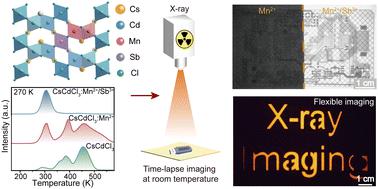当前位置:
X-MOL 学术
›
Mater. Chem. Front.
›
论文详情
Our official English website, www.x-mol.net, welcomes your
feedback! (Note: you will need to create a separate account there.)
Enhancing persistent radioluminescence in perovskite scintillators through trap defect modulation
Materials Chemistry Frontiers ( IF 6.0 ) Pub Date : 2024-05-17 , DOI: 10.1039/d4qm00039k Xiaokun Li 1 , Huixi Guo 2, 3 , Yahuang Li 1 , Caihou Lin 4 , Lili Xie 1
Materials Chemistry Frontiers ( IF 6.0 ) Pub Date : 2024-05-17 , DOI: 10.1039/d4qm00039k Xiaokun Li 1 , Huixi Guo 2, 3 , Yahuang Li 1 , Caihou Lin 4 , Lili Xie 1
Affiliation

|
Flexible X-ray sensors utilizing persistent radioluminescence scintillators have garnered considerable interest in medical imaging and industrial non-destructive testing. However, persistent radioluminescence in scintillators is typically generated by releasing stored electrons from deep trap defects at high temperatures, significantly limiting X-ray imaging sensitivity. The requirement of high temperatures for thermally-stimulated radioluminescence to erase harmful X-ray memory also impedes the repeated use of flexible sensors. Here we report high-efficiency persistent radioluminescence at room temperature by modulating the depth and density distribution of trap defects through codoping with Mn2+ and Sb3+ in CsCdCl3 scintillators. This results in a 20-fold increase in radioluminescence afterglow at room temperature, leading to significantly enhanced X-ray imaging sensitivity and facile erasure of harmful X-ray memory at relatively low temperatures for repeated use of the flexible sensors. Furthermore, the as-synthesized scintillators exhibit excellent resistance to thermal quenching, maintaining 96.63% radioluminescence efficiency at 493 K, and commendable stability concerning humidity and solvent exposure. Additionally, we fabricated flexible X-ray imaging sensors achieving high-resolution (20.0 lp mm−1) imaging of irregulate objects at room temperature using CsCdCl3:5%Mn2+/0.1%Sb3+ crystals. These findings provide valuable insights into ion doping for the regulation of trap defects in scintillators, motivating the development of high-resolution time-lapse X-ray imaging sensors.
更新日期:2024-05-17





















































 京公网安备 11010802027423号
京公网安备 11010802027423号